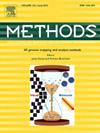利用纳米粒子辅助低温电子显微镜取样的各向异性取向
IF 4.3
3区 生物学
Q1 BIOCHEMICAL RESEARCH METHODS
引用次数: 0
摘要
测量小分子蛋白质的构象分布对于理解它们在生物系统中的作用至关重要。设计了多倾斜纳米粒子辅助低温电子显微镜采样(MT-NACS),通过在多个倾斜角度拍摄低温电子显微镜(cro - em)图像来测量标记在蛋白质上的两个金纳米粒子(AuNPs)的三维粒子间距离分布(P(d))。然而,在多倾斜低温电镜实验和数据分析中,以伪层析方式跟踪相同的粒子需要大量的时间和精力。在这里,我们报告了适当地结合AuNP对角度分布可以可靠地确定P(d),仅使用在单一倾斜角度下收集的冷冻电镜图像。单倾角NACS (ST-NACS)和MT-NACS测量的钙调素(CaM)结构变化趋势是一致的,因为两种方法测量的aunp标记CaM的P(d)变化趋势相似。我们的方法为测量小分子蛋白质的构象分布和结构转变提供了一种有效的工具。本文章由计算机程序翻译,如有差异,请以英文原文为准。

Exploiting Anisotropic Orientation in Nanoparticle-Aided Cryo-Electron Microscopy Sampling
Measuring the conformational distribution of small proteins is essential to understanding their role in biological systems. Multi-Tilt Nanoparticle-aided cryo-electron microscopy sampling (MT-NACS) was devised to measure the three-dimensional interparticle distance distribution (P(d)) of two gold nanoparticles (AuNPs) labeled on a protein by taking cryogenic electron microscopy (cryo-EM) images at multiple-tilt angles. However, tracking the same particles in a pseudo-tomographic manner during the multi-tilt cryo-EM experiments and data analysis requires extensive time and effort. Here, we report that proper incorporation of AuNP pair angle distribution allows reliable determination of the P(d) only using the cryo-EM images collected at a single tilt angle. The trends of structural changes in calmodulin (CaM) measured by single-tilt angle NACS (ST-NACS) and MT-NACS are consistent, as the tendencies of changes in the P(d) of AuNP-labeled CaM measured by both methods are similar. Our approach provides an efficient tool for measuring the conformational distribution and structural transition of small proteins.
求助全文
通过发布文献求助,成功后即可免费获取论文全文。
去求助
来源期刊

Methods
生物-生化研究方法
CiteScore
9.80
自引率
2.10%
发文量
222
审稿时长
11.3 weeks
期刊介绍:
Methods focuses on rapidly developing techniques in the experimental biological and medical sciences.
Each topical issue, organized by a guest editor who is an expert in the area covered, consists solely of invited quality articles by specialist authors, many of them reviews. Issues are devoted to specific technical approaches with emphasis on clear detailed descriptions of protocols that allow them to be reproduced easily. The background information provided enables researchers to understand the principles underlying the methods; other helpful sections include comparisons of alternative methods giving the advantages and disadvantages of particular methods, guidance on avoiding potential pitfalls, and suggestions for troubleshooting.
 求助内容:
求助内容: 应助结果提醒方式:
应助结果提醒方式:


